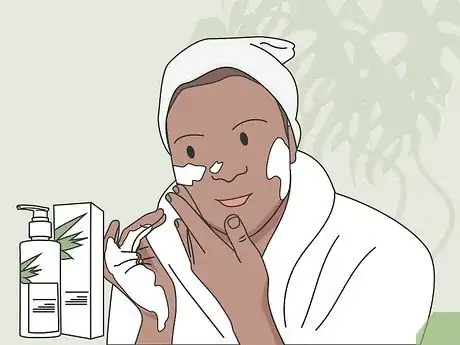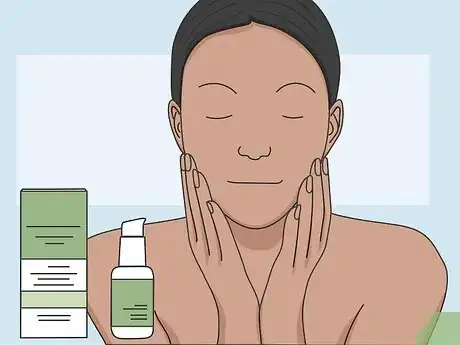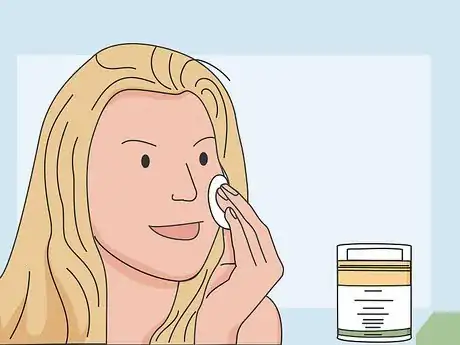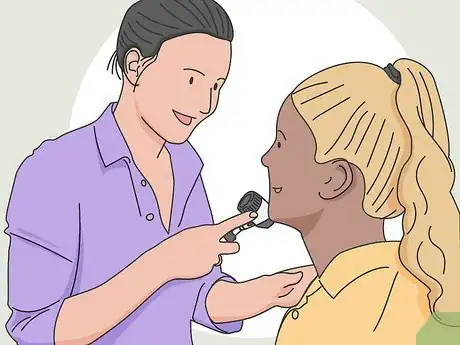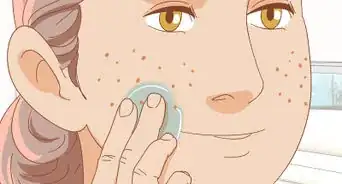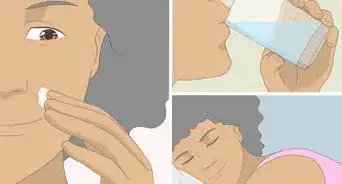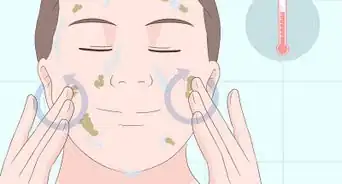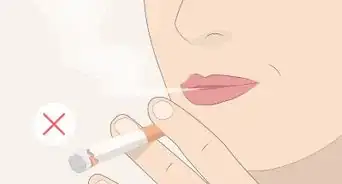This article was co-authored by Daniel Barrett, MD and by wikiHow staff writer, Jessica Gibson. Dr. Daniel Barrett is a Board Certified Plastic Surgeon and the owner of Barrett Plastic Surgery based in Beverly Hills, California. With over six years of plastic surgery experience, Dr. Barrett specializes in aesthetic and reconstructive surgery of the face, nose and body. He has developed detailed scar management protocols and closure techniques to reduce the appearance of scars for his patients. Dr. Barrett obtained a BS from James Madison University and an MD along with an MS in Physiology and and an MHA (Masters of Health Administration) from the Medical College of Virginia in Richmond.
There are 12 references cited in this article, which can be found at the bottom of the page.
This article has been viewed 22,071 times.
If you feel like your cheeks are sagging or they've lost their elasticity, adjust your skincare routine. Since facial wrinkles are more noticeable if the skin is dry, use a gentle cleanser that doesn't strip away protective oils before applying a hydrating moisturizer. Add anti-wrinkle skincare products and always protect your skin from sun damage by wearing sunscreen.
Steps
Following an Anti-Wrinkle Skincare Routine
-
1Wash your face with a gentle cleanser instead of soap. Look for a cleanser that doesn't contain sodium lauryl sulfate, which strips your skin of the natural oils that provide protection and moisture. Instead, use cleansers with natural ingredients, like tea tree oil, citrus, or apple cider vinegar. Rinse your face with water and massage a facial cleanser onto your skin before rinsing it off. Wash your face 1 to 2 times a day. This removes dead skin cells so your skin looks refreshed.[1]
- Buy a facial cleanser designed for your skin type. For example, use an oil-free or gel-based cleanser if you have oily skin. If you're prone to breakouts, get a sensitive-skin cleanser.[2]
-
2Massage an anti-wrinkle serum onto your clean face. To protect your skin from wrinkle-causing free radical damage, buy an anti-wrinkle serum that contains antioxidants, which reduce free radicals. The serum might also contain vitamin C and hyaluronic acid, which make your skin look fuller.[3]
- To apply the serum, squeeze 2 or 3 drops of an anti-wrinkle serum onto the palm of your hand. Rub the fingertips of your other hand in the serum and gently apply it to your entire face. Pay extra attention to the wrinkled areas of your cheeks.
Did You Know? Free radicals are unstable atoms that cause chemical changes in your skin. Many scientific studies have linked free radicals with cell damage, leading to signs of aging and possibly illness.[4]
Advertisement -
3Apply a daily moisturizer to make the wrinkles less visible.[5] If your skin is dry, fine lines and wrinkles on your cheeks are more noticeable. Always massage a moisturizer onto your skin immediately after you cleanse it. This plumps your skin and makes your cheeks appear fuller.[6]
- Re-apply moisturizer throughout the day if your skin feels dry.
- Avoid using a moisturizer that contains ingredients like perfume, dye, or preservatives since these can irritate your skin.
-
4Apply sunscreen throughout the day to protect your cheeks from further damage. The majority of wrinkles are caused by ultraviolet light, so apply a broad-spectrum sunscreen with an SPF of at least 15 throughout the day.[7] You should also cover your skin and stay in the shade to limit damage. For example, wear a wide-brimmed hat and carry an umbrella.[8]
Tip: Use a higher SPF if you'll be in direct sunlight during the day. Choose a sunscreen with at least 30 to 50 SPF and remember to reapply it every 2 hours.
-
5Use a nightly anti-wrinkle cream with vitamins C and E on your face. Buy an over-the-counter (OTC) product that has both of these vitamins. They work together to reduce wrinkles. Remember to wash your face to remove the day's makeup before applying the cream.[9]
- Most wrinkle cream manufacturers recommend that you apply the cream before you go to bed. This gives your skin the best chance to absorb the product.
-
6Add a retinol product to your skincare routine a few times a week. Buy an OTC retinol cream or gel and squeeze a pea-sized amount onto a fingertip. Massage the gel onto the skin of your entire face before you go to bed. The retinol stimulates collagen production, which makes your skin appear fuller. This reduces the look of wrinkles.[10]
- Retinol is also used to heal sun-damaged skin and treat skin conditions, such as acne or rosacea.
Making Lifestyle Changes
-
1Eat antioxidant-rich foods to protect your skin's collagen.[11] You may have heard that as you age, your body makes more free radicals, which can cause damage to your skin. Eating a diet full of antioxidants reduces free radicals. This protects the collagen in your skin that keeps your face looking healthy and firm. Include these foods in your diet:[12]
- Berries, such as strawberries, blueberries, cranberries, and blackberries
- Beans, such as pinto beans, red kidney beans, and black beans
- Leafy greens, such as spinach, kale, and lettuce
- Vegetables, such as carrots, broccoli, artichokes, and sweet potatoes
-
2Exercise regularly throughout the week to improve circulation. Get moving to increase blood flow to your skin, which helps repair damage and reduce wrinkles. You could jog, swim, play tennis, or strength train, for instance.[13]
Tip: You can also practice facial yoga, which has been shown to make your cheeks and lower face appear fuller. This can reduce the appearance of fine lines and wrinkles.
-
3Aim for at least 7 hours of sleep every night. Consistently getting enough sleep increases blood flow, and this improved circulation helps your skin rebuild collagen. Also, to prevent cheek wrinkles, try to sleep on your back. This reduces pressure on one side of your face that creates lines.[14]
- Consider buying a pillow that's designed to support your head if you sleep on your side or buy a pillowcase made of silk, which reduces pressure on your face.
-
4Quit smoking. Make an effort to quit or cut back on the amount you smoke. Cigarettes contain harmful materials that reduce the collagen and elastin in your skin. This causes your skin to sag or wrinkle. To get support, join a community group of people trying to quit or find a support group online.[15]
- Pursing your mouth the smoke also creates vertical wrinkles above your lips, so quitting can also reduce these lines.
-
5Make an appointment with a dermatologist if you have deep cheek wrinkles.[16] Although protecting your skin from damage and following an anti-wrinkle skincare routine can minimize fine lines and wrinkles, you might still have deep wrinkles that need medical treatment. Talk with a dermatologist about in-office treatments, which include chemical peels, dermabrasion, or filler injections.[17]
- If you've been using retinol for a few months but haven't seen an improvement, ask the dermatologist about prescription-strength retinoids, which might be more effective.
- Fillers for the cheeks are typically either made with calcium hydroxide apatite or hyaluronic acid.[18]
- Other techniques might include microneedling and CO2 or nonablative laser treatments.[19]
Expert Q&A
Did you know you can get expert answers for this article?
Unlock expert answers by supporting wikiHow
-
QuestionCan you reverse wrinkles on your face?
 Paul Friedman, MDPaul Friedman, MD, is a Board-Certified Dermatologist, and the Director and Founder of the Dermatology & Laser Surgery Center in Houston, Texas. He has over 25 years of experience and specializes in Mohs micrographic surgery, dermatologic laser surgery, and cosmetic dermatology. Dr. Friedman is the current President of the American Society for Laser Medicine & Surgery and was named by Newsweek Magazine as one of the Best Dermatologists in America for Laser Treatments. His awards include the Husk Prize for his research in dermatologic surgery and the Young Investigator's Writing Competition Award of the American Society for Dermatologic Surgery. Dr. Friedman completed his dermatology residency at the New York University School of Medicine and received his medical degree with the highest honors from the University of Tennessee Health Science Center, College of Medicine.
Paul Friedman, MDPaul Friedman, MD, is a Board-Certified Dermatologist, and the Director and Founder of the Dermatology & Laser Surgery Center in Houston, Texas. He has over 25 years of experience and specializes in Mohs micrographic surgery, dermatologic laser surgery, and cosmetic dermatology. Dr. Friedman is the current President of the American Society for Laser Medicine & Surgery and was named by Newsweek Magazine as one of the Best Dermatologists in America for Laser Treatments. His awards include the Husk Prize for his research in dermatologic surgery and the Young Investigator's Writing Competition Award of the American Society for Dermatologic Surgery. Dr. Friedman completed his dermatology residency at the New York University School of Medicine and received his medical degree with the highest honors from the University of Tennessee Health Science Center, College of Medicine.
Board Certified Dermatologist, American Board of Dermatology
-
QuestionHow can I tighten my skin?
 Paul Friedman, MDPaul Friedman, MD, is a Board-Certified Dermatologist, and the Director and Founder of the Dermatology & Laser Surgery Center in Houston, Texas. He has over 25 years of experience and specializes in Mohs micrographic surgery, dermatologic laser surgery, and cosmetic dermatology. Dr. Friedman is the current President of the American Society for Laser Medicine & Surgery and was named by Newsweek Magazine as one of the Best Dermatologists in America for Laser Treatments. His awards include the Husk Prize for his research in dermatologic surgery and the Young Investigator's Writing Competition Award of the American Society for Dermatologic Surgery. Dr. Friedman completed his dermatology residency at the New York University School of Medicine and received his medical degree with the highest honors from the University of Tennessee Health Science Center, College of Medicine.
Paul Friedman, MDPaul Friedman, MD, is a Board-Certified Dermatologist, and the Director and Founder of the Dermatology & Laser Surgery Center in Houston, Texas. He has over 25 years of experience and specializes in Mohs micrographic surgery, dermatologic laser surgery, and cosmetic dermatology. Dr. Friedman is the current President of the American Society for Laser Medicine & Surgery and was named by Newsweek Magazine as one of the Best Dermatologists in America for Laser Treatments. His awards include the Husk Prize for his research in dermatologic surgery and the Young Investigator's Writing Competition Award of the American Society for Dermatologic Surgery. Dr. Friedman completed his dermatology residency at the New York University School of Medicine and received his medical degree with the highest honors from the University of Tennessee Health Science Center, College of Medicine.
Board Certified Dermatologist, American Board of Dermatology
-
QuestionHow do I prevent collagen loss?
 Paul Friedman, MDPaul Friedman, MD, is a Board-Certified Dermatologist, and the Director and Founder of the Dermatology & Laser Surgery Center in Houston, Texas. He has over 25 years of experience and specializes in Mohs micrographic surgery, dermatologic laser surgery, and cosmetic dermatology. Dr. Friedman is the current President of the American Society for Laser Medicine & Surgery and was named by Newsweek Magazine as one of the Best Dermatologists in America for Laser Treatments. His awards include the Husk Prize for his research in dermatologic surgery and the Young Investigator's Writing Competition Award of the American Society for Dermatologic Surgery. Dr. Friedman completed his dermatology residency at the New York University School of Medicine and received his medical degree with the highest honors from the University of Tennessee Health Science Center, College of Medicine.
Paul Friedman, MDPaul Friedman, MD, is a Board-Certified Dermatologist, and the Director and Founder of the Dermatology & Laser Surgery Center in Houston, Texas. He has over 25 years of experience and specializes in Mohs micrographic surgery, dermatologic laser surgery, and cosmetic dermatology. Dr. Friedman is the current President of the American Society for Laser Medicine & Surgery and was named by Newsweek Magazine as one of the Best Dermatologists in America for Laser Treatments. His awards include the Husk Prize for his research in dermatologic surgery and the Young Investigator's Writing Competition Award of the American Society for Dermatologic Surgery. Dr. Friedman completed his dermatology residency at the New York University School of Medicine and received his medical degree with the highest honors from the University of Tennessee Health Science Center, College of Medicine.
Board Certified Dermatologist, American Board of Dermatology
Warnings
- Because of the risk for birth defects, avoid using retinoid products if you're pregnant.[21]⧼thumbs_response⧽
References
- ↑ https://www.webmd.com/beauty/features/23-ways-to-reduce-wrinkles#1
- ↑ Paul Friedman, MD. Board Certified Dermatologist, American Board of Dermatology. Expert Interview. 8 April 2020.
- ↑ https://youtu.be/z9RMAMbO7dw?t=120
- ↑ https://www.medicalnewstoday.com/articles/318652#How-do-free-radicals-damage-the-body
- ↑ Paul Friedman, MD. Board Certified Dermatologist, American Board of Dermatology. Expert Interview. 8 April 2020.
- ↑ https://www.webmd.com/beauty/features/23-ways-to-reduce-wrinkles#1
- ↑ Paul Friedman, MD. Board Certified Dermatologist, American Board of Dermatology. Expert Interview. 8 April 2020.
- ↑ https://newsnetwork.mayoclinic.org/discussion/steps-can-be-taken-to-make-wrinkles-less-noticeable/
- ↑ https://newsnetwork.mayoclinic.org/discussion/steps-can-be-taken-to-make-wrinkles-less-noticeable/
- ↑ https://www.ncbi.nlm.nih.gov/pmc/articles/PMC2699641/
- ↑ Paul Friedman, MD. Board Certified Dermatologist, American Board of Dermatology. Expert Interview. 8 April 2020.
- ↑ http://www.stjohns.health/documents/cognitive-health/top-20-foods-high-in-antioxidants.pdf
- ↑ https://www.ncbi.nlm.nih.gov/pmc/articles/PMC5885810/
- ↑ https://www.ncbi.nlm.nih.gov/pubmed/22506801
- ↑ https://newsnetwork.mayoclinic.org/discussion/steps-can-be-taken-to-make-wrinkles-less-noticeable/
- ↑ Paul Friedman, MD. Board Certified Dermatologist, American Board of Dermatology. Expert Interview. 8 April 2020.
- ↑ https://newsnetwork.mayoclinic.org/discussion/steps-can-be-taken-to-make-wrinkles-less-noticeable/
- ↑ Daniel Barrett, MD. Board Certified Plastic Surgeon. Expert Interview. 9 December 2020.
- ↑ Daniel Barrett, MD. Board Certified Plastic Surgeon. Expert Interview. 9 December 2020.
- ↑ https://globalnews.ca/news/4113894/skincare-routine-effects-time/
- ↑ https://www.ncbi.nlm.nih.gov/pmc/articles/PMC3114665/
